BSc Health & Social Care: Culture, Society, and Ethics Essay Analysis
VerifiedAdded on 2022/12/23
|9
|3626
|1
Essay
AI Summary
This essay delves into the critical intersection of culture, society, and ethics within the realm of health and social care. It emphasizes the significance of health promotion planning in fostering public health, addressing social inequalities in healthcare, and upholding dignity and equality in service provision. The essay explores the importance of ethical cultures and climates in healthcare settings, highlighting the role of ethical business standards in decision-making and the promotion of equality through legislation like the Equality Act 2010. It examines the crucial role of equality and diversity in meeting the diverse needs of service users, particularly those with disabilities or illnesses. The essay also analyzes relevant legislation, including the Human Rights Act and the Care Act 2014, underscoring their importance in protecting human rights and improving service quality. Furthermore, it discusses the impact of discrimination, stigma, and stereotypes on patient care and well-being, emphasizing the need for anti-oppressive practices and ethical conduct to ensure equitable treatment and promote patient dignity. The essay concludes by highlighting the role of communication, anti-discriminatory practices, and the importance of ethical standards in the healthcare environment.
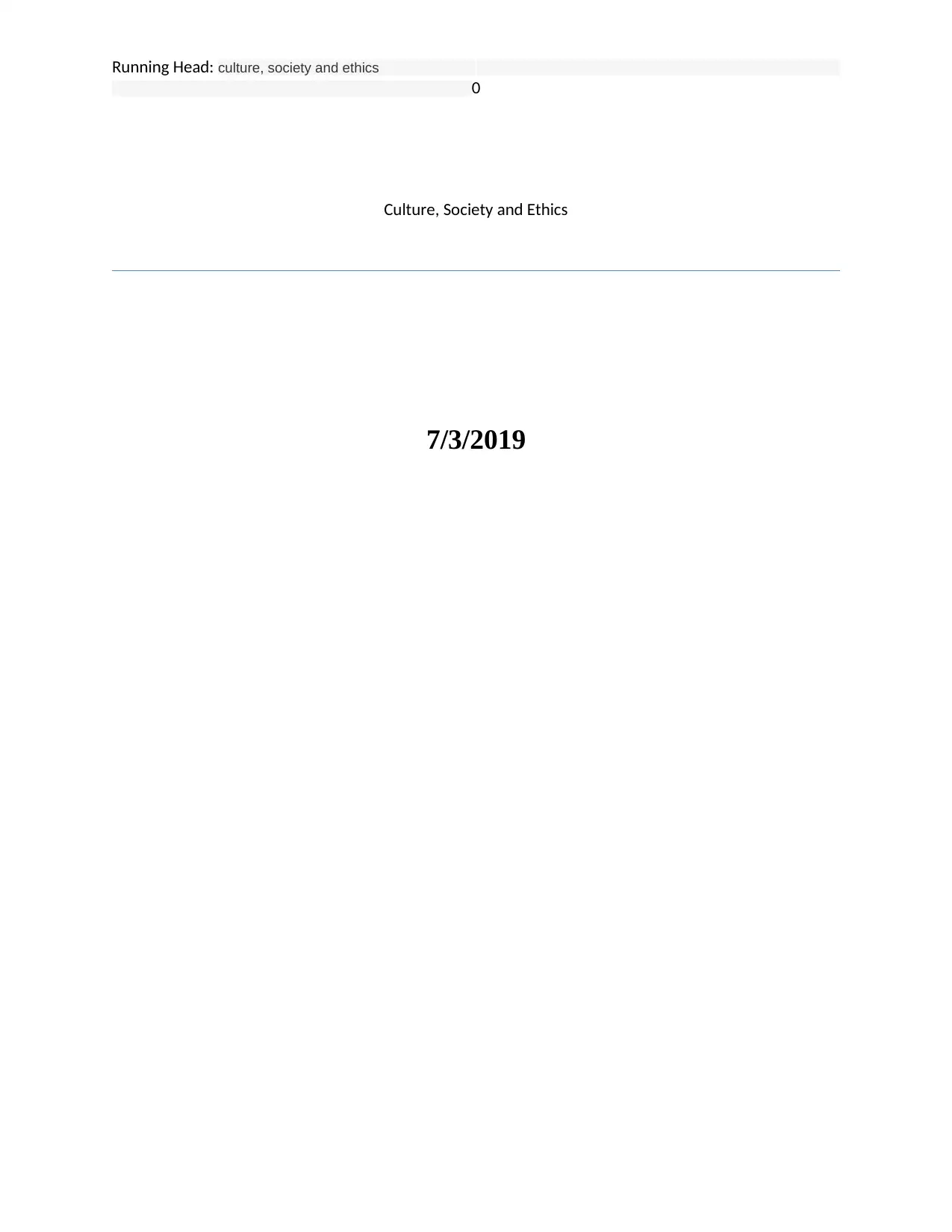
Running Head: culture, society and ethics
0
Culture, Society and Ethics
7/3/2019
0
Culture, Society and Ethics
7/3/2019
Paraphrase This Document
Need a fresh take? Get an instant paraphrase of this document with our AI Paraphraser
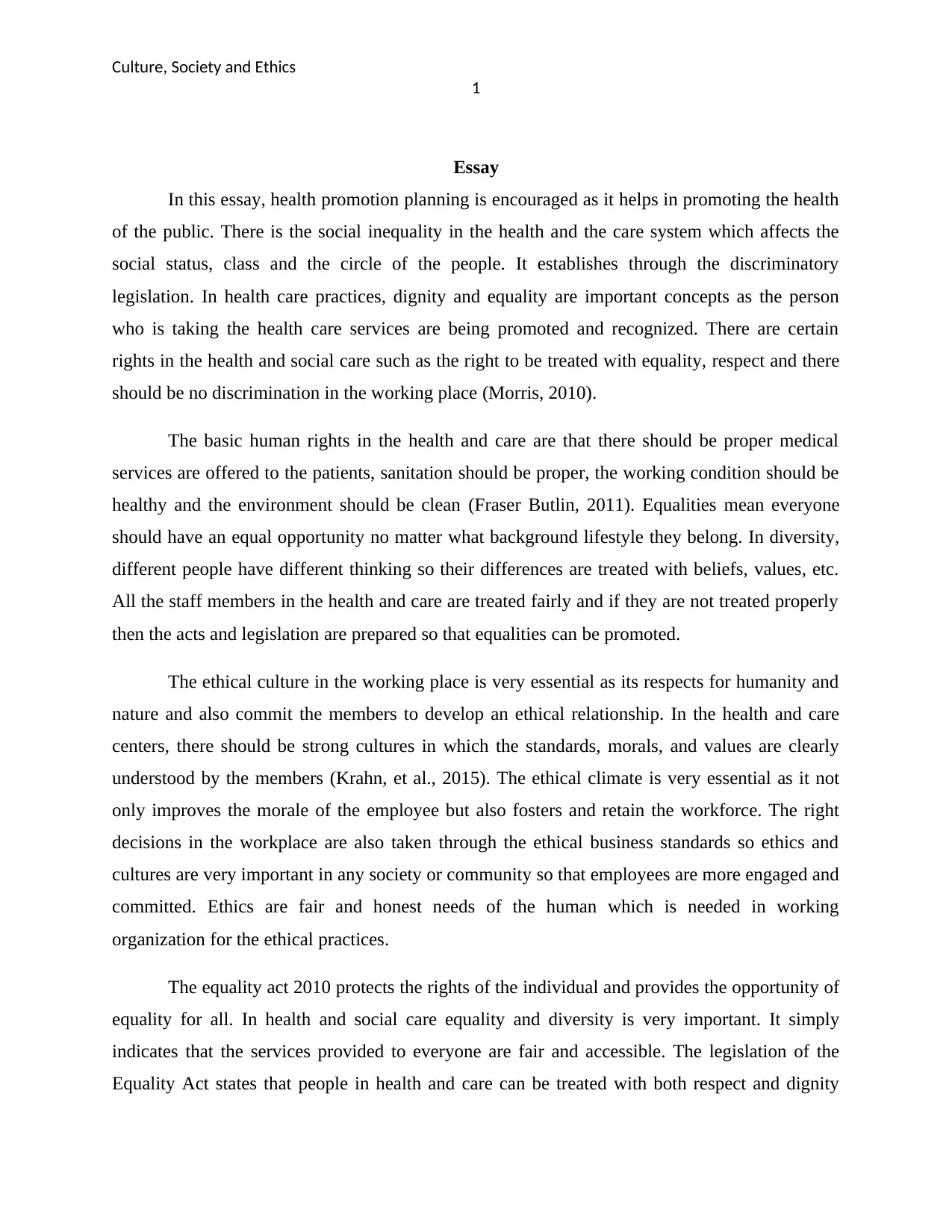
Culture, Society and Ethics
1
Essay
In this essay, health promotion planning is encouraged as it helps in promoting the health
of the public. There is the social inequality in the health and the care system which affects the
social status, class and the circle of the people. It establishes through the discriminatory
legislation. In health care practices, dignity and equality are important concepts as the person
who is taking the health care services are being promoted and recognized. There are certain
rights in the health and social care such as the right to be treated with equality, respect and there
should be no discrimination in the working place (Morris, 2010).
The basic human rights in the health and care are that there should be proper medical
services are offered to the patients, sanitation should be proper, the working condition should be
healthy and the environment should be clean (Fraser Butlin, 2011). Equalities mean everyone
should have an equal opportunity no matter what background lifestyle they belong. In diversity,
different people have different thinking so their differences are treated with beliefs, values, etc.
All the staff members in the health and care are treated fairly and if they are not treated properly
then the acts and legislation are prepared so that equalities can be promoted.
The ethical culture in the working place is very essential as its respects for humanity and
nature and also commit the members to develop an ethical relationship. In the health and care
centers, there should be strong cultures in which the standards, morals, and values are clearly
understood by the members (Krahn, et al., 2015). The ethical climate is very essential as it not
only improves the morale of the employee but also fosters and retain the workforce. The right
decisions in the workplace are also taken through the ethical business standards so ethics and
cultures are very important in any society or community so that employees are more engaged and
committed. Ethics are fair and honest needs of the human which is needed in working
organization for the ethical practices.
The equality act 2010 protects the rights of the individual and provides the opportunity of
equality for all. In health and social care equality and diversity is very important. It simply
indicates that the services provided to everyone are fair and accessible. The legislation of the
Equality Act states that people in health and care can be treated with both respect and dignity
1
Essay
In this essay, health promotion planning is encouraged as it helps in promoting the health
of the public. There is the social inequality in the health and the care system which affects the
social status, class and the circle of the people. It establishes through the discriminatory
legislation. In health care practices, dignity and equality are important concepts as the person
who is taking the health care services are being promoted and recognized. There are certain
rights in the health and social care such as the right to be treated with equality, respect and there
should be no discrimination in the working place (Morris, 2010).
The basic human rights in the health and care are that there should be proper medical
services are offered to the patients, sanitation should be proper, the working condition should be
healthy and the environment should be clean (Fraser Butlin, 2011). Equalities mean everyone
should have an equal opportunity no matter what background lifestyle they belong. In diversity,
different people have different thinking so their differences are treated with beliefs, values, etc.
All the staff members in the health and care are treated fairly and if they are not treated properly
then the acts and legislation are prepared so that equalities can be promoted.
The ethical culture in the working place is very essential as its respects for humanity and
nature and also commit the members to develop an ethical relationship. In the health and care
centers, there should be strong cultures in which the standards, morals, and values are clearly
understood by the members (Krahn, et al., 2015). The ethical climate is very essential as it not
only improves the morale of the employee but also fosters and retain the workforce. The right
decisions in the workplace are also taken through the ethical business standards so ethics and
cultures are very important in any society or community so that employees are more engaged and
committed. Ethics are fair and honest needs of the human which is needed in working
organization for the ethical practices.
The equality act 2010 protects the rights of the individual and provides the opportunity of
equality for all. In health and social care equality and diversity is very important. It simply
indicates that the services provided to everyone are fair and accessible. The legislation of the
Equality Act states that people in health and care can be treated with both respect and dignity
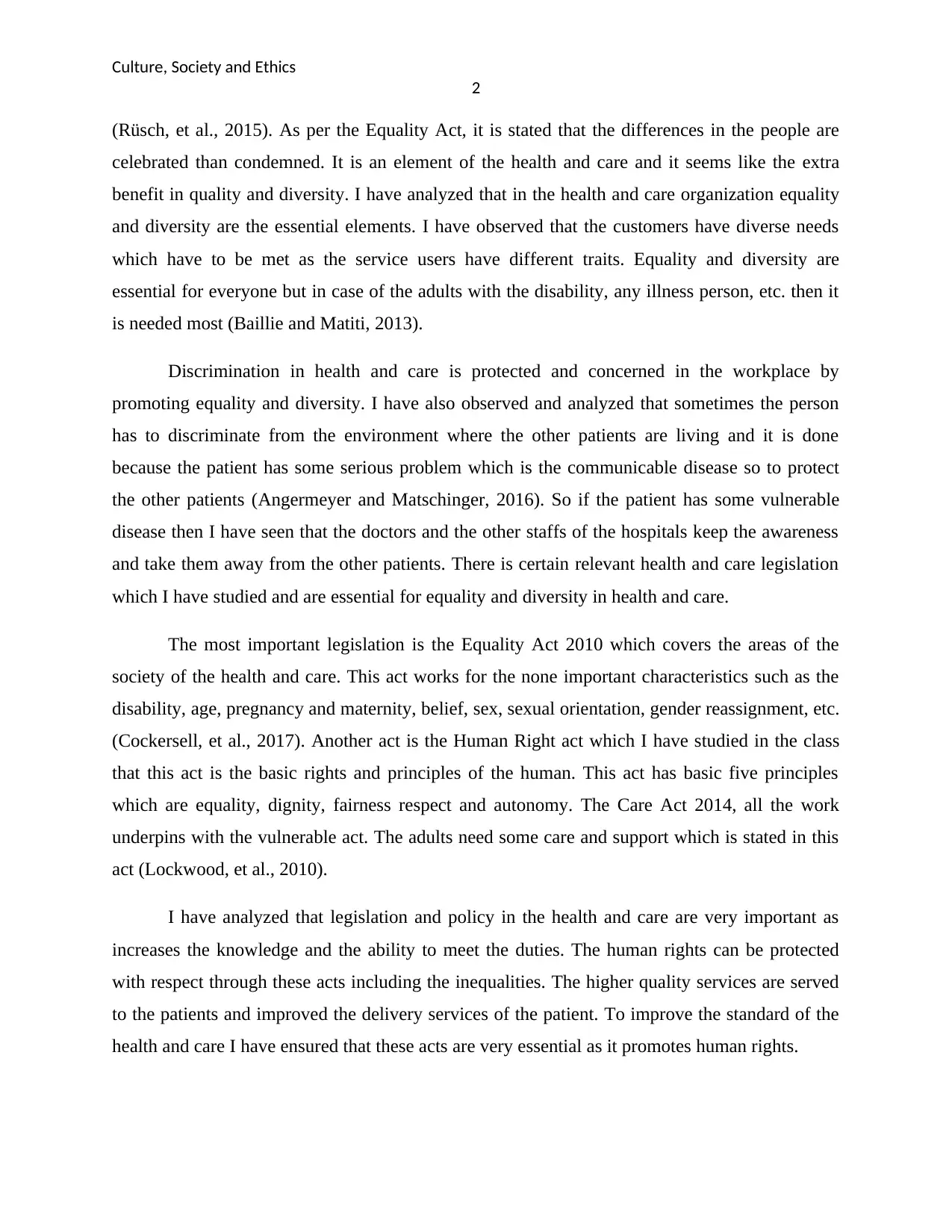
Culture, Society and Ethics
2
(Rüsch, et al., 2015). As per the Equality Act, it is stated that the differences in the people are
celebrated than condemned. It is an element of the health and care and it seems like the extra
benefit in quality and diversity. I have analyzed that in the health and care organization equality
and diversity are the essential elements. I have observed that the customers have diverse needs
which have to be met as the service users have different traits. Equality and diversity are
essential for everyone but in case of the adults with the disability, any illness person, etc. then it
is needed most (Baillie and Matiti, 2013).
Discrimination in health and care is protected and concerned in the workplace by
promoting equality and diversity. I have also observed and analyzed that sometimes the person
has to discriminate from the environment where the other patients are living and it is done
because the patient has some serious problem which is the communicable disease so to protect
the other patients (Angermeyer and Matschinger, 2016). So if the patient has some vulnerable
disease then I have seen that the doctors and the other staffs of the hospitals keep the awareness
and take them away from the other patients. There is certain relevant health and care legislation
which I have studied and are essential for equality and diversity in health and care.
The most important legislation is the Equality Act 2010 which covers the areas of the
society of the health and care. This act works for the none important characteristics such as the
disability, age, pregnancy and maternity, belief, sex, sexual orientation, gender reassignment, etc.
(Cockersell, et al., 2017). Another act is the Human Right act which I have studied in the class
that this act is the basic rights and principles of the human. This act has basic five principles
which are equality, dignity, fairness respect and autonomy. The Care Act 2014, all the work
underpins with the vulnerable act. The adults need some care and support which is stated in this
act (Lockwood, et al., 2010).
I have analyzed that legislation and policy in the health and care are very important as
increases the knowledge and the ability to meet the duties. The human rights can be protected
with respect through these acts including the inequalities. The higher quality services are served
to the patients and improved the delivery services of the patient. To improve the standard of the
health and care I have ensured that these acts are very essential as it promotes human rights.
2
(Rüsch, et al., 2015). As per the Equality Act, it is stated that the differences in the people are
celebrated than condemned. It is an element of the health and care and it seems like the extra
benefit in quality and diversity. I have analyzed that in the health and care organization equality
and diversity are the essential elements. I have observed that the customers have diverse needs
which have to be met as the service users have different traits. Equality and diversity are
essential for everyone but in case of the adults with the disability, any illness person, etc. then it
is needed most (Baillie and Matiti, 2013).
Discrimination in health and care is protected and concerned in the workplace by
promoting equality and diversity. I have also observed and analyzed that sometimes the person
has to discriminate from the environment where the other patients are living and it is done
because the patient has some serious problem which is the communicable disease so to protect
the other patients (Angermeyer and Matschinger, 2016). So if the patient has some vulnerable
disease then I have seen that the doctors and the other staffs of the hospitals keep the awareness
and take them away from the other patients. There is certain relevant health and care legislation
which I have studied and are essential for equality and diversity in health and care.
The most important legislation is the Equality Act 2010 which covers the areas of the
society of the health and care. This act works for the none important characteristics such as the
disability, age, pregnancy and maternity, belief, sex, sexual orientation, gender reassignment, etc.
(Cockersell, et al., 2017). Another act is the Human Right act which I have studied in the class
that this act is the basic rights and principles of the human. This act has basic five principles
which are equality, dignity, fairness respect and autonomy. The Care Act 2014, all the work
underpins with the vulnerable act. The adults need some care and support which is stated in this
act (Lockwood, et al., 2010).
I have analyzed that legislation and policy in the health and care are very important as
increases the knowledge and the ability to meet the duties. The human rights can be protected
with respect through these acts including the inequalities. The higher quality services are served
to the patients and improved the delivery services of the patient. To improve the standard of the
health and care I have ensured that these acts are very essential as it promotes human rights.
⊘ This is a preview!⊘
Do you want full access?
Subscribe today to unlock all pages.

Trusted by 1+ million students worldwide
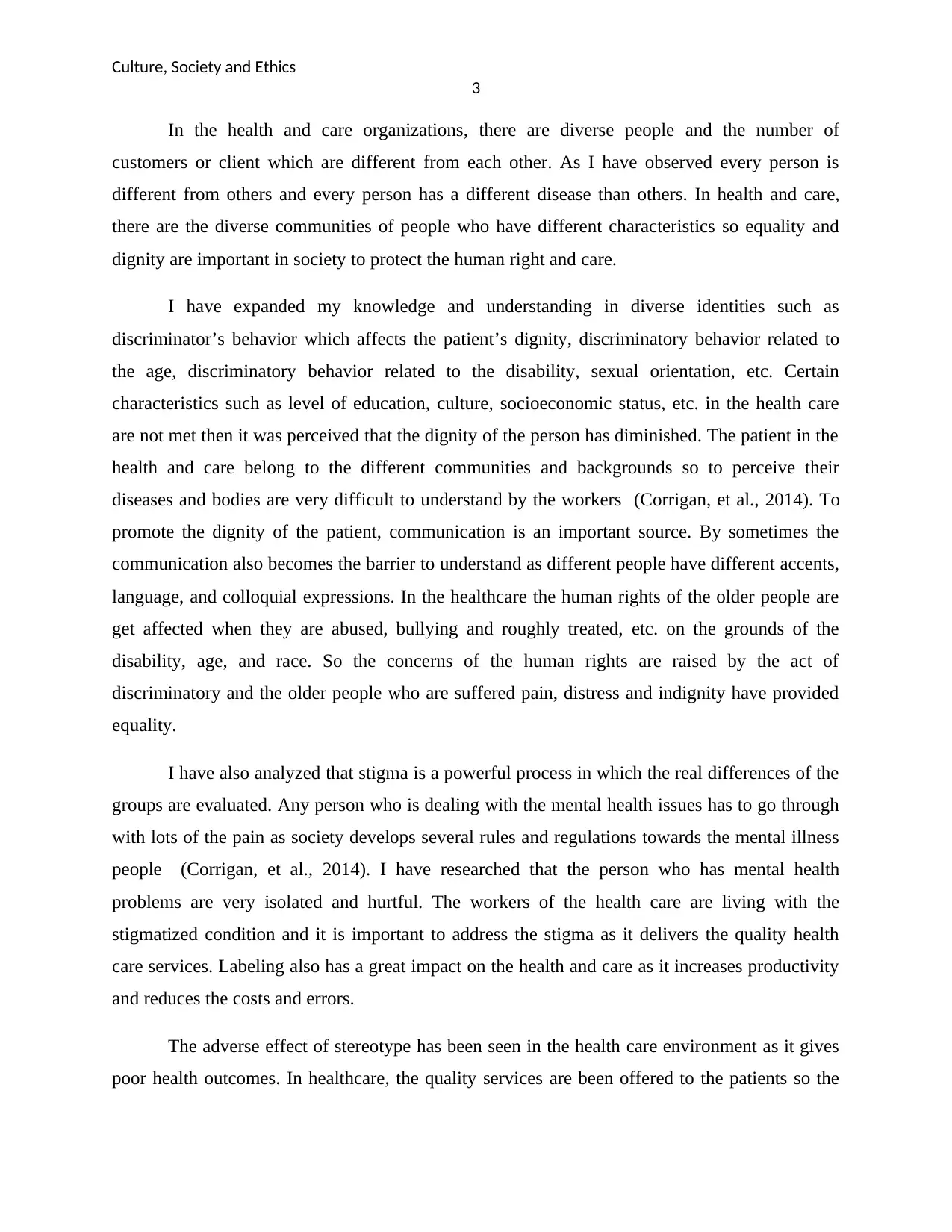
Culture, Society and Ethics
3
In the health and care organizations, there are diverse people and the number of
customers or client which are different from each other. As I have observed every person is
different from others and every person has a different disease than others. In health and care,
there are the diverse communities of people who have different characteristics so equality and
dignity are important in society to protect the human right and care.
I have expanded my knowledge and understanding in diverse identities such as
discriminator’s behavior which affects the patient’s dignity, discriminatory behavior related to
the age, discriminatory behavior related to the disability, sexual orientation, etc. Certain
characteristics such as level of education, culture, socioeconomic status, etc. in the health care
are not met then it was perceived that the dignity of the person has diminished. The patient in the
health and care belong to the different communities and backgrounds so to perceive their
diseases and bodies are very difficult to understand by the workers (Corrigan, et al., 2014). To
promote the dignity of the patient, communication is an important source. By sometimes the
communication also becomes the barrier to understand as different people have different accents,
language, and colloquial expressions. In the healthcare the human rights of the older people are
get affected when they are abused, bullying and roughly treated, etc. on the grounds of the
disability, age, and race. So the concerns of the human rights are raised by the act of
discriminatory and the older people who are suffered pain, distress and indignity have provided
equality.
I have also analyzed that stigma is a powerful process in which the real differences of the
groups are evaluated. Any person who is dealing with the mental health issues has to go through
with lots of the pain as society develops several rules and regulations towards the mental illness
people (Corrigan, et al., 2014). I have researched that the person who has mental health
problems are very isolated and hurtful. The workers of the health care are living with the
stigmatized condition and it is important to address the stigma as it delivers the quality health
care services. Labeling also has a great impact on the health and care as it increases productivity
and reduces the costs and errors.
The adverse effect of stereotype has been seen in the health care environment as it gives
poor health outcomes. In healthcare, the quality services are been offered to the patients so the
3
In the health and care organizations, there are diverse people and the number of
customers or client which are different from each other. As I have observed every person is
different from others and every person has a different disease than others. In health and care,
there are the diverse communities of people who have different characteristics so equality and
dignity are important in society to protect the human right and care.
I have expanded my knowledge and understanding in diverse identities such as
discriminator’s behavior which affects the patient’s dignity, discriminatory behavior related to
the age, discriminatory behavior related to the disability, sexual orientation, etc. Certain
characteristics such as level of education, culture, socioeconomic status, etc. in the health care
are not met then it was perceived that the dignity of the person has diminished. The patient in the
health and care belong to the different communities and backgrounds so to perceive their
diseases and bodies are very difficult to understand by the workers (Corrigan, et al., 2014). To
promote the dignity of the patient, communication is an important source. By sometimes the
communication also becomes the barrier to understand as different people have different accents,
language, and colloquial expressions. In the healthcare the human rights of the older people are
get affected when they are abused, bullying and roughly treated, etc. on the grounds of the
disability, age, and race. So the concerns of the human rights are raised by the act of
discriminatory and the older people who are suffered pain, distress and indignity have provided
equality.
I have also analyzed that stigma is a powerful process in which the real differences of the
groups are evaluated. Any person who is dealing with the mental health issues has to go through
with lots of the pain as society develops several rules and regulations towards the mental illness
people (Corrigan, et al., 2014). I have researched that the person who has mental health
problems are very isolated and hurtful. The workers of the health care are living with the
stigmatized condition and it is important to address the stigma as it delivers the quality health
care services. Labeling also has a great impact on the health and care as it increases productivity
and reduces the costs and errors.
The adverse effect of stereotype has been seen in the health care environment as it gives
poor health outcomes. In healthcare, the quality services are been offered to the patients so the
Paraphrase This Document
Need a fresh take? Get an instant paraphrase of this document with our AI Paraphraser
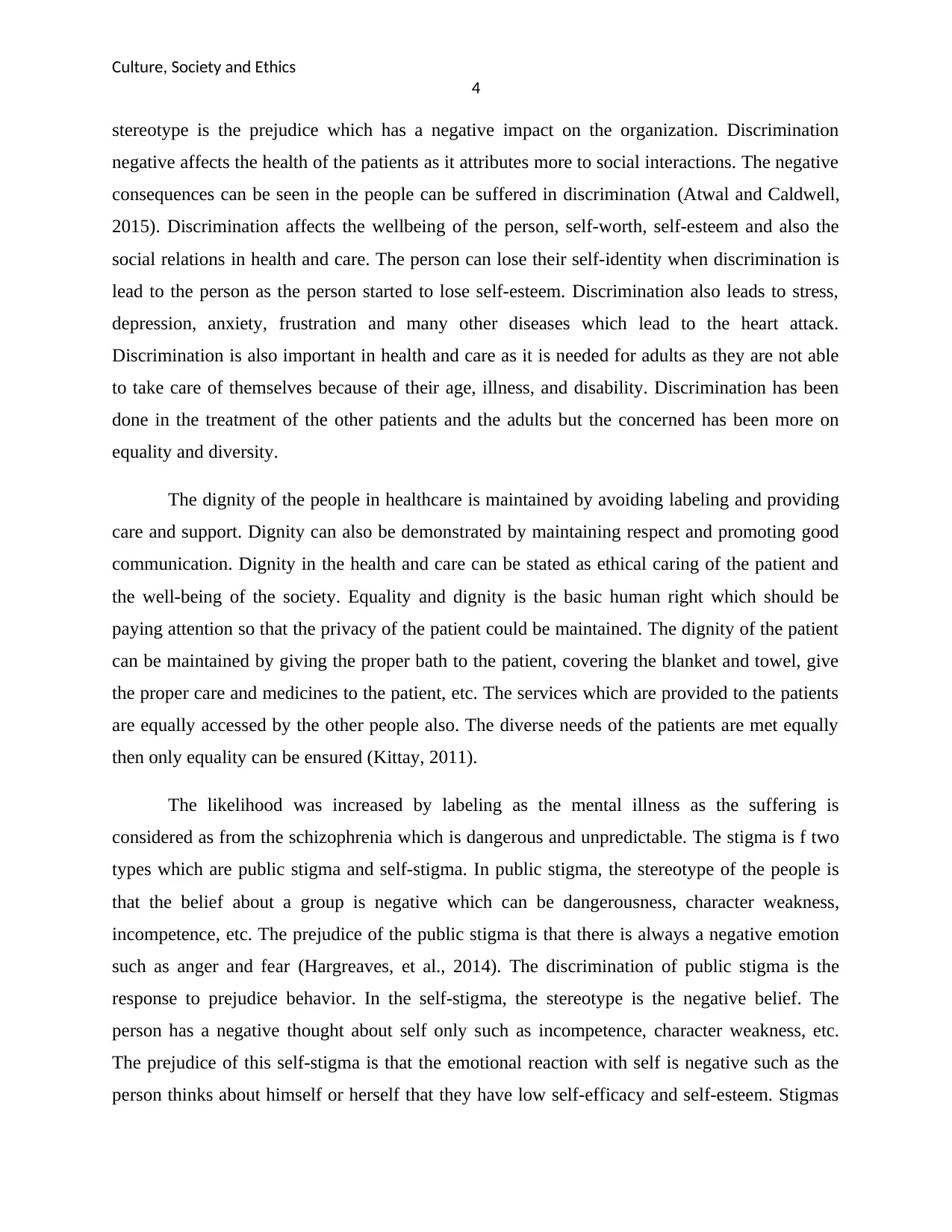
Culture, Society and Ethics
4
stereotype is the prejudice which has a negative impact on the organization. Discrimination
negative affects the health of the patients as it attributes more to social interactions. The negative
consequences can be seen in the people can be suffered in discrimination (Atwal and Caldwell,
2015). Discrimination affects the wellbeing of the person, self-worth, self-esteem and also the
social relations in health and care. The person can lose their self-identity when discrimination is
lead to the person as the person started to lose self-esteem. Discrimination also leads to stress,
depression, anxiety, frustration and many other diseases which lead to the heart attack.
Discrimination is also important in health and care as it is needed for adults as they are not able
to take care of themselves because of their age, illness, and disability. Discrimination has been
done in the treatment of the other patients and the adults but the concerned has been more on
equality and diversity.
The dignity of the people in healthcare is maintained by avoiding labeling and providing
care and support. Dignity can also be demonstrated by maintaining respect and promoting good
communication. Dignity in the health and care can be stated as ethical caring of the patient and
the well-being of the society. Equality and dignity is the basic human right which should be
paying attention so that the privacy of the patient could be maintained. The dignity of the patient
can be maintained by giving the proper bath to the patient, covering the blanket and towel, give
the proper care and medicines to the patient, etc. The services which are provided to the patients
are equally accessed by the other people also. The diverse needs of the patients are met equally
then only equality can be ensured (Kittay, 2011).
The likelihood was increased by labeling as the mental illness as the suffering is
considered as from the schizophrenia which is dangerous and unpredictable. The stigma is f two
types which are public stigma and self-stigma. In public stigma, the stereotype of the people is
that the belief about a group is negative which can be dangerousness, character weakness,
incompetence, etc. The prejudice of the public stigma is that there is always a negative emotion
such as anger and fear (Hargreaves, et al., 2014). The discrimination of public stigma is the
response to prejudice behavior. In the self-stigma, the stereotype is the negative belief. The
person has a negative thought about self only such as incompetence, character weakness, etc.
The prejudice of this self-stigma is that the emotional reaction with self is negative such as the
person thinks about himself or herself that they have low self-efficacy and self-esteem. Stigmas
4
stereotype is the prejudice which has a negative impact on the organization. Discrimination
negative affects the health of the patients as it attributes more to social interactions. The negative
consequences can be seen in the people can be suffered in discrimination (Atwal and Caldwell,
2015). Discrimination affects the wellbeing of the person, self-worth, self-esteem and also the
social relations in health and care. The person can lose their self-identity when discrimination is
lead to the person as the person started to lose self-esteem. Discrimination also leads to stress,
depression, anxiety, frustration and many other diseases which lead to the heart attack.
Discrimination is also important in health and care as it is needed for adults as they are not able
to take care of themselves because of their age, illness, and disability. Discrimination has been
done in the treatment of the other patients and the adults but the concerned has been more on
equality and diversity.
The dignity of the people in healthcare is maintained by avoiding labeling and providing
care and support. Dignity can also be demonstrated by maintaining respect and promoting good
communication. Dignity in the health and care can be stated as ethical caring of the patient and
the well-being of the society. Equality and dignity is the basic human right which should be
paying attention so that the privacy of the patient could be maintained. The dignity of the patient
can be maintained by giving the proper bath to the patient, covering the blanket and towel, give
the proper care and medicines to the patient, etc. The services which are provided to the patients
are equally accessed by the other people also. The diverse needs of the patients are met equally
then only equality can be ensured (Kittay, 2011).
The likelihood was increased by labeling as the mental illness as the suffering is
considered as from the schizophrenia which is dangerous and unpredictable. The stigma is f two
types which are public stigma and self-stigma. In public stigma, the stereotype of the people is
that the belief about a group is negative which can be dangerousness, character weakness,
incompetence, etc. The prejudice of the public stigma is that there is always a negative emotion
such as anger and fear (Hargreaves, et al., 2014). The discrimination of public stigma is the
response to prejudice behavior. In the self-stigma, the stereotype is the negative belief. The
person has a negative thought about self only such as incompetence, character weakness, etc.
The prejudice of this self-stigma is that the emotional reaction with self is negative such as the
person thinks about himself or herself that they have low self-efficacy and self-esteem. Stigmas
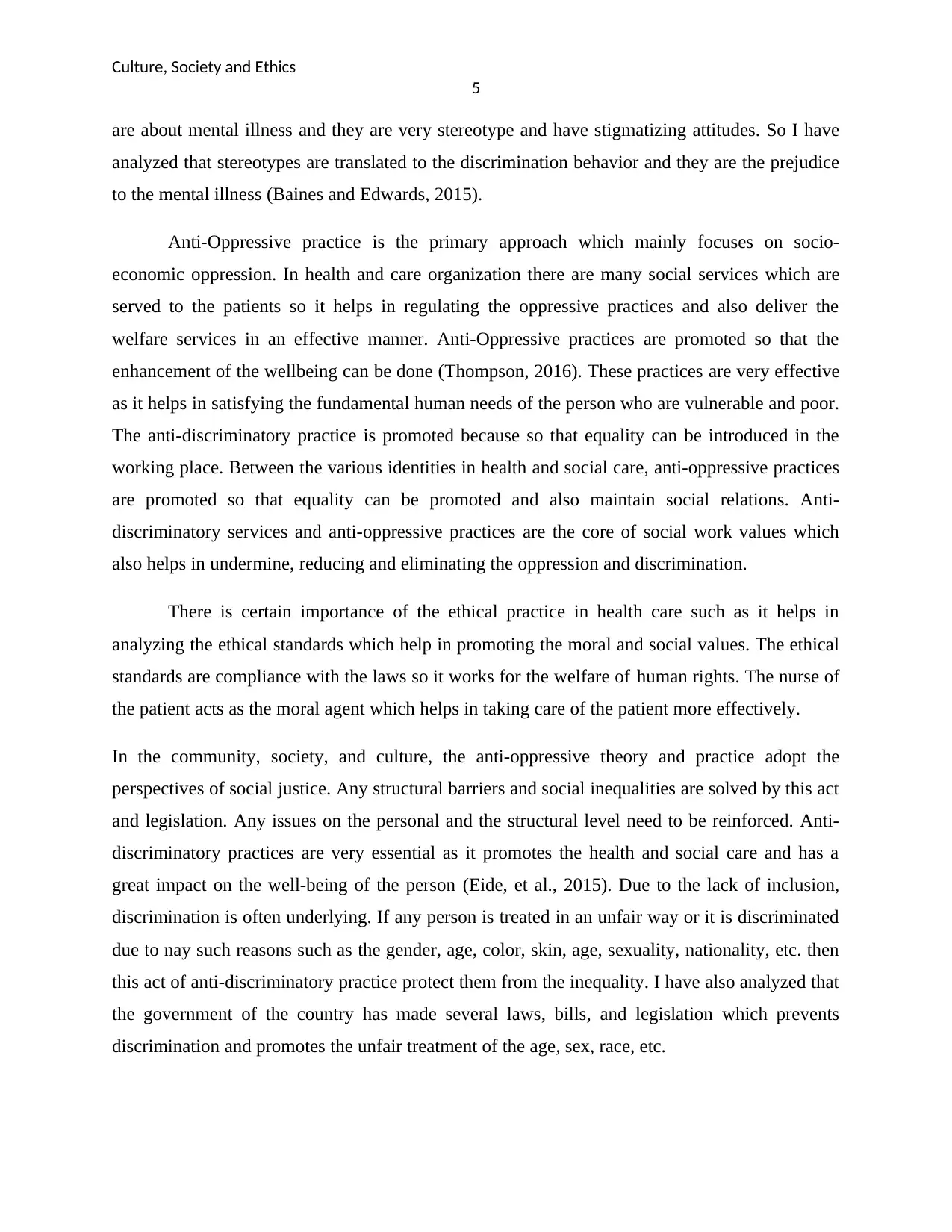
Culture, Society and Ethics
5
are about mental illness and they are very stereotype and have stigmatizing attitudes. So I have
analyzed that stereotypes are translated to the discrimination behavior and they are the prejudice
to the mental illness (Baines and Edwards, 2015).
Anti-Oppressive practice is the primary approach which mainly focuses on socio-
economic oppression. In health and care organization there are many social services which are
served to the patients so it helps in regulating the oppressive practices and also deliver the
welfare services in an effective manner. Anti-Oppressive practices are promoted so that the
enhancement of the wellbeing can be done (Thompson, 2016). These practices are very effective
as it helps in satisfying the fundamental human needs of the person who are vulnerable and poor.
The anti-discriminatory practice is promoted because so that equality can be introduced in the
working place. Between the various identities in health and social care, anti-oppressive practices
are promoted so that equality can be promoted and also maintain social relations. Anti-
discriminatory services and anti-oppressive practices are the core of social work values which
also helps in undermine, reducing and eliminating the oppression and discrimination.
There is certain importance of the ethical practice in health care such as it helps in
analyzing the ethical standards which help in promoting the moral and social values. The ethical
standards are compliance with the laws so it works for the welfare of human rights. The nurse of
the patient acts as the moral agent which helps in taking care of the patient more effectively.
In the community, society, and culture, the anti-oppressive theory and practice adopt the
perspectives of social justice. Any structural barriers and social inequalities are solved by this act
and legislation. Any issues on the personal and the structural level need to be reinforced. Anti-
discriminatory practices are very essential as it promotes the health and social care and has a
great impact on the well-being of the person (Eide, et al., 2015). Due to the lack of inclusion,
discrimination is often underlying. If any person is treated in an unfair way or it is discriminated
due to nay such reasons such as the gender, age, color, skin, age, sexuality, nationality, etc. then
this act of anti-discriminatory practice protect them from the inequality. I have also analyzed that
the government of the country has made several laws, bills, and legislation which prevents
discrimination and promotes the unfair treatment of the age, sex, race, etc.
5
are about mental illness and they are very stereotype and have stigmatizing attitudes. So I have
analyzed that stereotypes are translated to the discrimination behavior and they are the prejudice
to the mental illness (Baines and Edwards, 2015).
Anti-Oppressive practice is the primary approach which mainly focuses on socio-
economic oppression. In health and care organization there are many social services which are
served to the patients so it helps in regulating the oppressive practices and also deliver the
welfare services in an effective manner. Anti-Oppressive practices are promoted so that the
enhancement of the wellbeing can be done (Thompson, 2016). These practices are very effective
as it helps in satisfying the fundamental human needs of the person who are vulnerable and poor.
The anti-discriminatory practice is promoted because so that equality can be introduced in the
working place. Between the various identities in health and social care, anti-oppressive practices
are promoted so that equality can be promoted and also maintain social relations. Anti-
discriminatory services and anti-oppressive practices are the core of social work values which
also helps in undermine, reducing and eliminating the oppression and discrimination.
There is certain importance of the ethical practice in health care such as it helps in
analyzing the ethical standards which help in promoting the moral and social values. The ethical
standards are compliance with the laws so it works for the welfare of human rights. The nurse of
the patient acts as the moral agent which helps in taking care of the patient more effectively.
In the community, society, and culture, the anti-oppressive theory and practice adopt the
perspectives of social justice. Any structural barriers and social inequalities are solved by this act
and legislation. Any issues on the personal and the structural level need to be reinforced. Anti-
discriminatory practices are very essential as it promotes the health and social care and has a
great impact on the well-being of the person (Eide, et al., 2015). Due to the lack of inclusion,
discrimination is often underlying. If any person is treated in an unfair way or it is discriminated
due to nay such reasons such as the gender, age, color, skin, age, sexuality, nationality, etc. then
this act of anti-discriminatory practice protect them from the inequality. I have also analyzed that
the government of the country has made several laws, bills, and legislation which prevents
discrimination and promotes the unfair treatment of the age, sex, race, etc.
⊘ This is a preview!⊘
Do you want full access?
Subscribe today to unlock all pages.

Trusted by 1+ million students worldwide
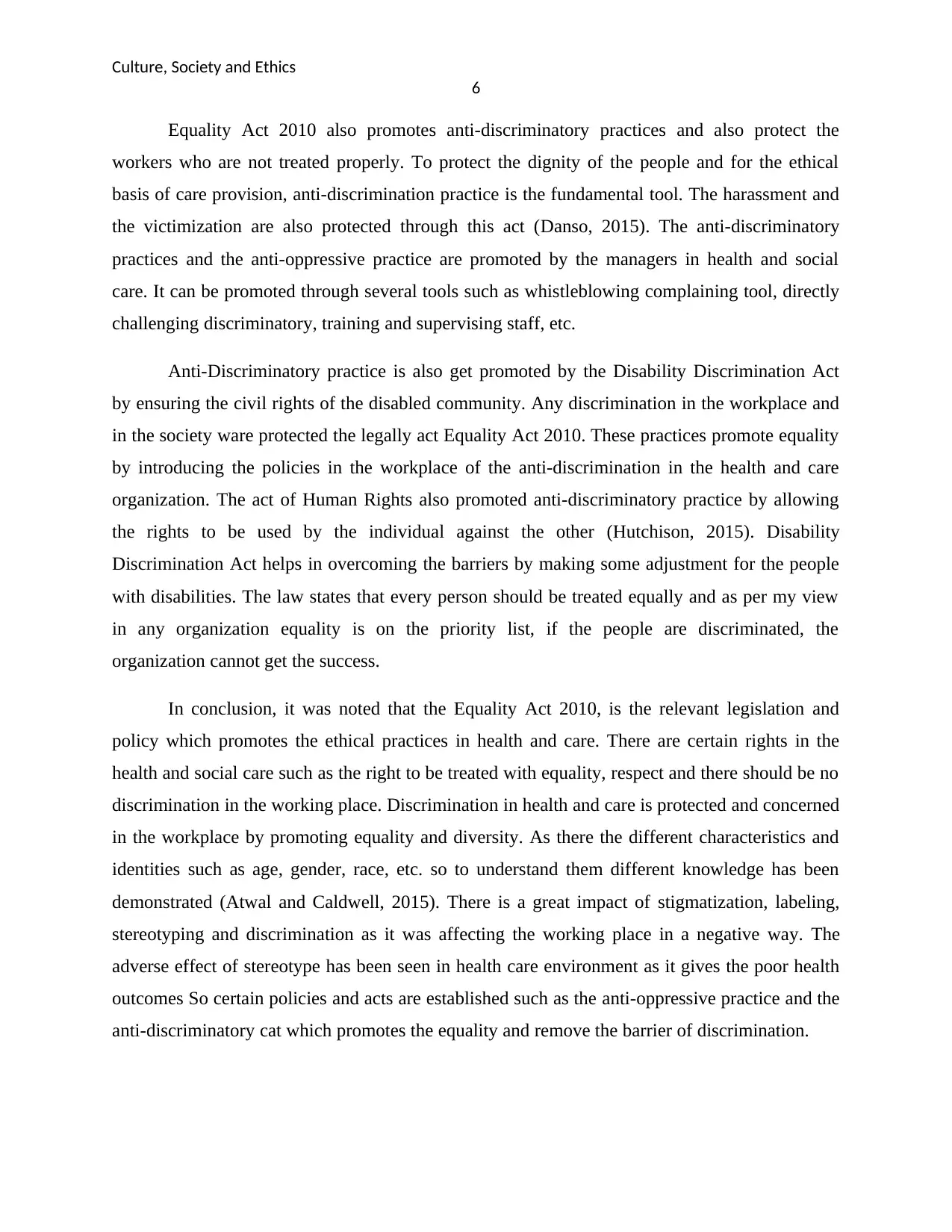
Culture, Society and Ethics
6
Equality Act 2010 also promotes anti-discriminatory practices and also protect the
workers who are not treated properly. To protect the dignity of the people and for the ethical
basis of care provision, anti-discrimination practice is the fundamental tool. The harassment and
the victimization are also protected through this act (Danso, 2015). The anti-discriminatory
practices and the anti-oppressive practice are promoted by the managers in health and social
care. It can be promoted through several tools such as whistleblowing complaining tool, directly
challenging discriminatory, training and supervising staff, etc.
Anti-Discriminatory practice is also get promoted by the Disability Discrimination Act
by ensuring the civil rights of the disabled community. Any discrimination in the workplace and
in the society ware protected the legally act Equality Act 2010. These practices promote equality
by introducing the policies in the workplace of the anti-discrimination in the health and care
organization. The act of Human Rights also promoted anti-discriminatory practice by allowing
the rights to be used by the individual against the other (Hutchison, 2015). Disability
Discrimination Act helps in overcoming the barriers by making some adjustment for the people
with disabilities. The law states that every person should be treated equally and as per my view
in any organization equality is on the priority list, if the people are discriminated, the
organization cannot get the success.
In conclusion, it was noted that the Equality Act 2010, is the relevant legislation and
policy which promotes the ethical practices in health and care. There are certain rights in the
health and social care such as the right to be treated with equality, respect and there should be no
discrimination in the working place. Discrimination in health and care is protected and concerned
in the workplace by promoting equality and diversity. As there the different characteristics and
identities such as age, gender, race, etc. so to understand them different knowledge has been
demonstrated (Atwal and Caldwell, 2015). There is a great impact of stigmatization, labeling,
stereotyping and discrimination as it was affecting the working place in a negative way. The
adverse effect of stereotype has been seen in health care environment as it gives the poor health
outcomes So certain policies and acts are established such as the anti-oppressive practice and the
anti-discriminatory cat which promotes the equality and remove the barrier of discrimination.
6
Equality Act 2010 also promotes anti-discriminatory practices and also protect the
workers who are not treated properly. To protect the dignity of the people and for the ethical
basis of care provision, anti-discrimination practice is the fundamental tool. The harassment and
the victimization are also protected through this act (Danso, 2015). The anti-discriminatory
practices and the anti-oppressive practice are promoted by the managers in health and social
care. It can be promoted through several tools such as whistleblowing complaining tool, directly
challenging discriminatory, training and supervising staff, etc.
Anti-Discriminatory practice is also get promoted by the Disability Discrimination Act
by ensuring the civil rights of the disabled community. Any discrimination in the workplace and
in the society ware protected the legally act Equality Act 2010. These practices promote equality
by introducing the policies in the workplace of the anti-discrimination in the health and care
organization. The act of Human Rights also promoted anti-discriminatory practice by allowing
the rights to be used by the individual against the other (Hutchison, 2015). Disability
Discrimination Act helps in overcoming the barriers by making some adjustment for the people
with disabilities. The law states that every person should be treated equally and as per my view
in any organization equality is on the priority list, if the people are discriminated, the
organization cannot get the success.
In conclusion, it was noted that the Equality Act 2010, is the relevant legislation and
policy which promotes the ethical practices in health and care. There are certain rights in the
health and social care such as the right to be treated with equality, respect and there should be no
discrimination in the working place. Discrimination in health and care is protected and concerned
in the workplace by promoting equality and diversity. As there the different characteristics and
identities such as age, gender, race, etc. so to understand them different knowledge has been
demonstrated (Atwal and Caldwell, 2015). There is a great impact of stigmatization, labeling,
stereotyping and discrimination as it was affecting the working place in a negative way. The
adverse effect of stereotype has been seen in health care environment as it gives the poor health
outcomes So certain policies and acts are established such as the anti-oppressive practice and the
anti-discriminatory cat which promotes the equality and remove the barrier of discrimination.
Paraphrase This Document
Need a fresh take? Get an instant paraphrase of this document with our AI Paraphraser
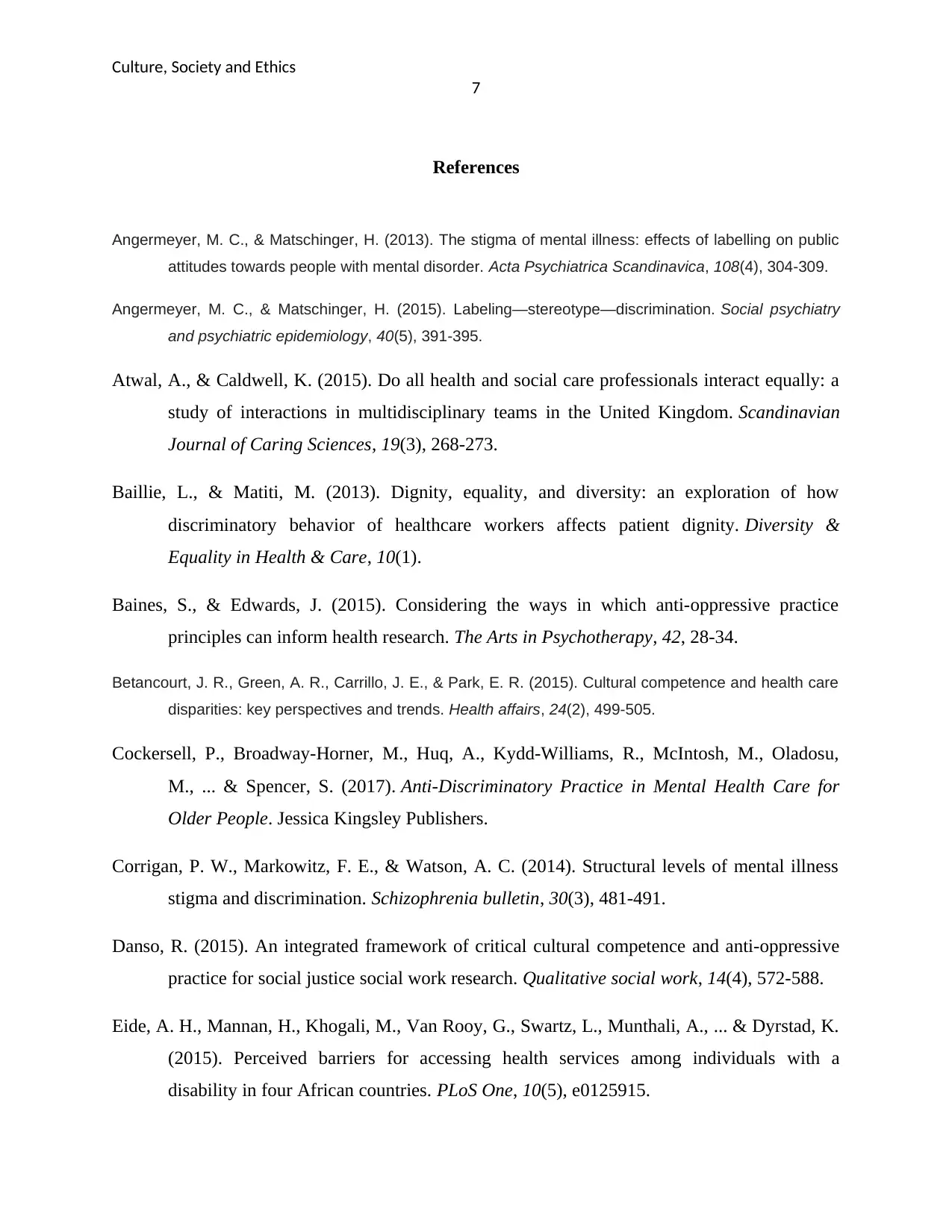
Culture, Society and Ethics
7
References
Angermeyer, M. C., & Matschinger, H. (2013). The stigma of mental illness: effects of labelling on public
attitudes towards people with mental disorder. Acta Psychiatrica Scandinavica, 108(4), 304-309.
Angermeyer, M. C., & Matschinger, H. (2015). Labeling—stereotype—discrimination. Social psychiatry
and psychiatric epidemiology, 40(5), 391-395.
Atwal, A., & Caldwell, K. (2015). Do all health and social care professionals interact equally: a
study of interactions in multidisciplinary teams in the United Kingdom. Scandinavian
Journal of Caring Sciences, 19(3), 268-273.
Baillie, L., & Matiti, M. (2013). Dignity, equality, and diversity: an exploration of how
discriminatory behavior of healthcare workers affects patient dignity. Diversity &
Equality in Health & Care, 10(1).
Baines, S., & Edwards, J. (2015). Considering the ways in which anti-oppressive practice
principles can inform health research. The Arts in Psychotherapy, 42, 28-34.
Betancourt, J. R., Green, A. R., Carrillo, J. E., & Park, E. R. (2015). Cultural competence and health care
disparities: key perspectives and trends. Health affairs, 24(2), 499-505.
Cockersell, P., Broadway-Horner, M., Huq, A., Kydd-Williams, R., McIntosh, M., Oladosu,
M., ... & Spencer, S. (2017). Anti-Discriminatory Practice in Mental Health Care for
Older People. Jessica Kingsley Publishers.
Corrigan, P. W., Markowitz, F. E., & Watson, A. C. (2014). Structural levels of mental illness
stigma and discrimination. Schizophrenia bulletin, 30(3), 481-491.
Danso, R. (2015). An integrated framework of critical cultural competence and anti-oppressive
practice for social justice social work research. Qualitative social work, 14(4), 572-588.
Eide, A. H., Mannan, H., Khogali, M., Van Rooy, G., Swartz, L., Munthali, A., ... & Dyrstad, K.
(2015). Perceived barriers for accessing health services among individuals with a
disability in four African countries. PLoS One, 10(5), e0125915.
7
References
Angermeyer, M. C., & Matschinger, H. (2013). The stigma of mental illness: effects of labelling on public
attitudes towards people with mental disorder. Acta Psychiatrica Scandinavica, 108(4), 304-309.
Angermeyer, M. C., & Matschinger, H. (2015). Labeling—stereotype—discrimination. Social psychiatry
and psychiatric epidemiology, 40(5), 391-395.
Atwal, A., & Caldwell, K. (2015). Do all health and social care professionals interact equally: a
study of interactions in multidisciplinary teams in the United Kingdom. Scandinavian
Journal of Caring Sciences, 19(3), 268-273.
Baillie, L., & Matiti, M. (2013). Dignity, equality, and diversity: an exploration of how
discriminatory behavior of healthcare workers affects patient dignity. Diversity &
Equality in Health & Care, 10(1).
Baines, S., & Edwards, J. (2015). Considering the ways in which anti-oppressive practice
principles can inform health research. The Arts in Psychotherapy, 42, 28-34.
Betancourt, J. R., Green, A. R., Carrillo, J. E., & Park, E. R. (2015). Cultural competence and health care
disparities: key perspectives and trends. Health affairs, 24(2), 499-505.
Cockersell, P., Broadway-Horner, M., Huq, A., Kydd-Williams, R., McIntosh, M., Oladosu,
M., ... & Spencer, S. (2017). Anti-Discriminatory Practice in Mental Health Care for
Older People. Jessica Kingsley Publishers.
Corrigan, P. W., Markowitz, F. E., & Watson, A. C. (2014). Structural levels of mental illness
stigma and discrimination. Schizophrenia bulletin, 30(3), 481-491.
Danso, R. (2015). An integrated framework of critical cultural competence and anti-oppressive
practice for social justice social work research. Qualitative social work, 14(4), 572-588.
Eide, A. H., Mannan, H., Khogali, M., Van Rooy, G., Swartz, L., Munthali, A., ... & Dyrstad, K.
(2015). Perceived barriers for accessing health services among individuals with a
disability in four African countries. PLoS One, 10(5), e0125915.
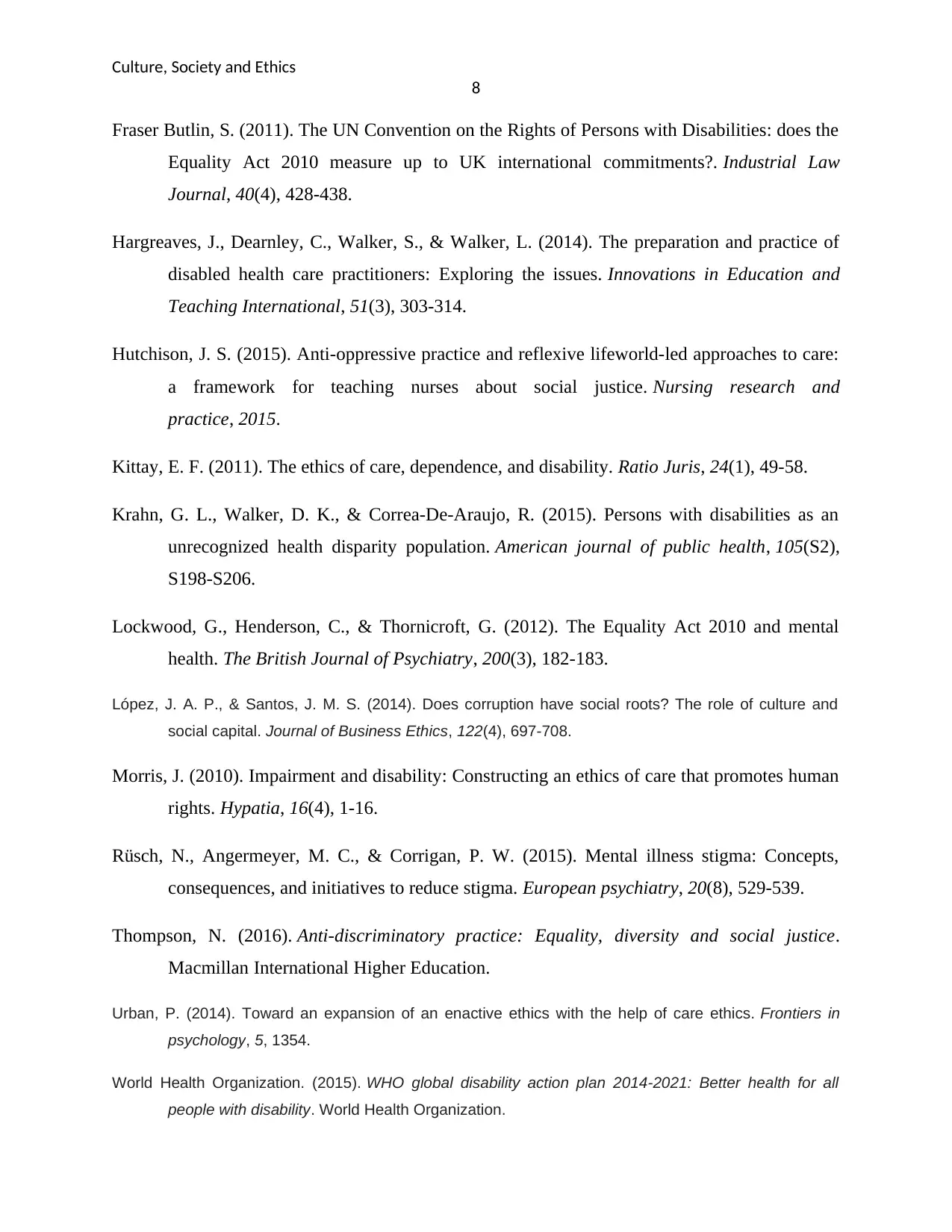
Culture, Society and Ethics
8
Fraser Butlin, S. (2011). The UN Convention on the Rights of Persons with Disabilities: does the
Equality Act 2010 measure up to UK international commitments?. Industrial Law
Journal, 40(4), 428-438.
Hargreaves, J., Dearnley, C., Walker, S., & Walker, L. (2014). The preparation and practice of
disabled health care practitioners: Exploring the issues. Innovations in Education and
Teaching International, 51(3), 303-314.
Hutchison, J. S. (2015). Anti-oppressive practice and reflexive lifeworld-led approaches to care:
a framework for teaching nurses about social justice. Nursing research and
practice, 2015.
Kittay, E. F. (2011). The ethics of care, dependence, and disability. Ratio Juris, 24(1), 49-58.
Krahn, G. L., Walker, D. K., & Correa-De-Araujo, R. (2015). Persons with disabilities as an
unrecognized health disparity population. American journal of public health, 105(S2),
S198-S206.
Lockwood, G., Henderson, C., & Thornicroft, G. (2012). The Equality Act 2010 and mental
health. The British Journal of Psychiatry, 200(3), 182-183.
López, J. A. P., & Santos, J. M. S. (2014). Does corruption have social roots? The role of culture and
social capital. Journal of Business Ethics, 122(4), 697-708.
Morris, J. (2010). Impairment and disability: Constructing an ethics of care that promotes human
rights. Hypatia, 16(4), 1-16.
Rüsch, N., Angermeyer, M. C., & Corrigan, P. W. (2015). Mental illness stigma: Concepts,
consequences, and initiatives to reduce stigma. European psychiatry, 20(8), 529-539.
Thompson, N. (2016). Anti-discriminatory practice: Equality, diversity and social justice.
Macmillan International Higher Education.
Urban, P. (2014). Toward an expansion of an enactive ethics with the help of care ethics. Frontiers in
psychology, 5, 1354.
World Health Organization. (2015). WHO global disability action plan 2014-2021: Better health for all
people with disability. World Health Organization.
8
Fraser Butlin, S. (2011). The UN Convention on the Rights of Persons with Disabilities: does the
Equality Act 2010 measure up to UK international commitments?. Industrial Law
Journal, 40(4), 428-438.
Hargreaves, J., Dearnley, C., Walker, S., & Walker, L. (2014). The preparation and practice of
disabled health care practitioners: Exploring the issues. Innovations in Education and
Teaching International, 51(3), 303-314.
Hutchison, J. S. (2015). Anti-oppressive practice and reflexive lifeworld-led approaches to care:
a framework for teaching nurses about social justice. Nursing research and
practice, 2015.
Kittay, E. F. (2011). The ethics of care, dependence, and disability. Ratio Juris, 24(1), 49-58.
Krahn, G. L., Walker, D. K., & Correa-De-Araujo, R. (2015). Persons with disabilities as an
unrecognized health disparity population. American journal of public health, 105(S2),
S198-S206.
Lockwood, G., Henderson, C., & Thornicroft, G. (2012). The Equality Act 2010 and mental
health. The British Journal of Psychiatry, 200(3), 182-183.
López, J. A. P., & Santos, J. M. S. (2014). Does corruption have social roots? The role of culture and
social capital. Journal of Business Ethics, 122(4), 697-708.
Morris, J. (2010). Impairment and disability: Constructing an ethics of care that promotes human
rights. Hypatia, 16(4), 1-16.
Rüsch, N., Angermeyer, M. C., & Corrigan, P. W. (2015). Mental illness stigma: Concepts,
consequences, and initiatives to reduce stigma. European psychiatry, 20(8), 529-539.
Thompson, N. (2016). Anti-discriminatory practice: Equality, diversity and social justice.
Macmillan International Higher Education.
Urban, P. (2014). Toward an expansion of an enactive ethics with the help of care ethics. Frontiers in
psychology, 5, 1354.
World Health Organization. (2015). WHO global disability action plan 2014-2021: Better health for all
people with disability. World Health Organization.
⊘ This is a preview!⊘
Do you want full access?
Subscribe today to unlock all pages.

Trusted by 1+ million students worldwide
1 out of 9
Related Documents
Your All-in-One AI-Powered Toolkit for Academic Success.
+13062052269
info@desklib.com
Available 24*7 on WhatsApp / Email
![[object Object]](/_next/static/media/star-bottom.7253800d.svg)
Unlock your academic potential
Copyright © 2020–2025 A2Z Services. All Rights Reserved. Developed and managed by ZUCOL.





